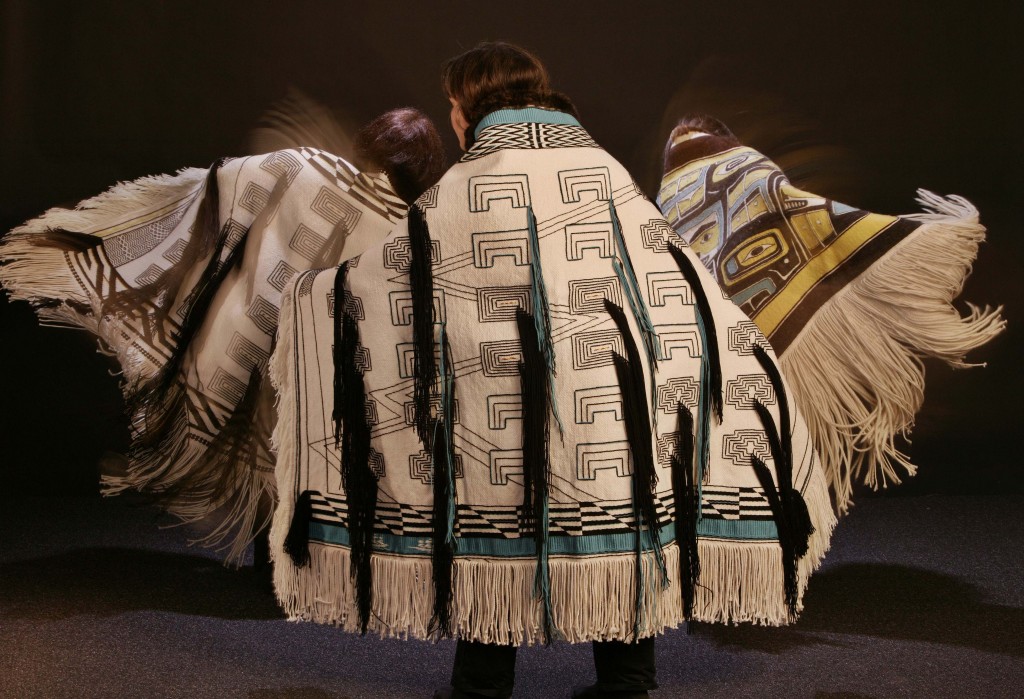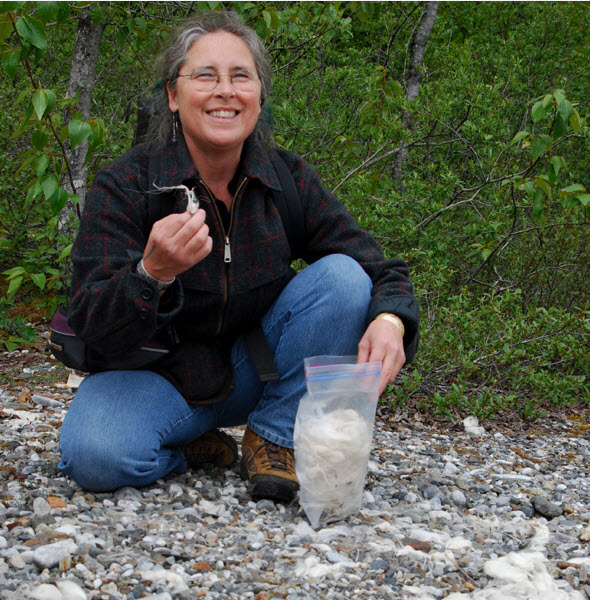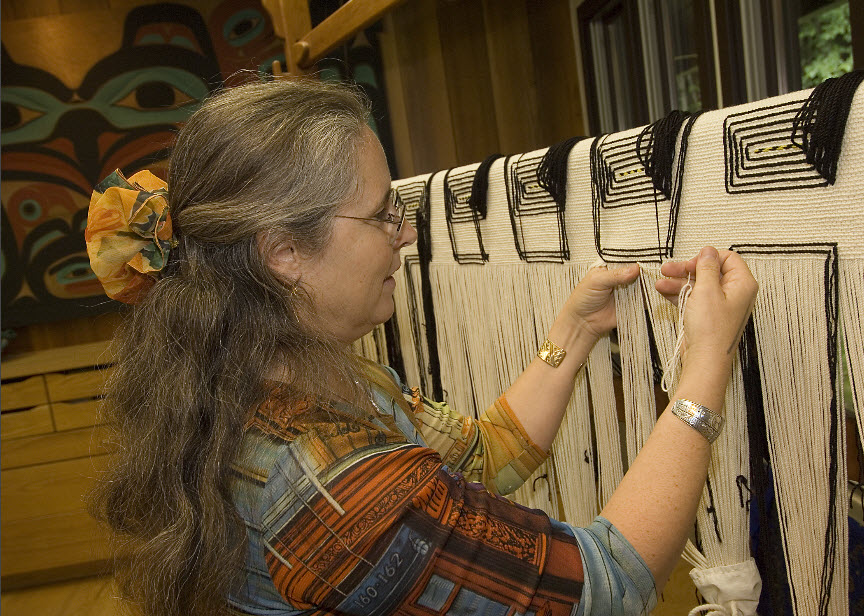Jordan Wright
March 2012
Special to Indian Country Today Media Network
Teri Rofkar (Tlingit of the Raven Clan from the Snail House) of the Sitka Tribe of Alaska sees patterns and shapes emerge from wool and roots. Using cedar, spruce tree roots, ferns, and mountain goat wool she collects in the woods, and along the shoreline of her Northwest coast home, the internationally renowned artist has been weaving exquisite baskets and textiles for over 25 years. Her robes are made with traditional Sitka freehand weaving techniques that date back over 6,000 years. Descending from a family of weavers she is inspired by “a deep connection to my ancestors.”
In creating ceremonial regalia she weaves in the once lost art of the Tlingit Raven’s Tail style of twining that uses ‘formline’ figures to represent the creature or spirit. Rofkar’s expertise also extends to the more highly stylized and representational Chilkat style of curvilinear and circular forms, one of the most complex weaving techniques in the world and the only one that can create perfect circles. Chilkat robes feature long wool fringe and are used for both ceremonial as well as dancing robes.
But though these loom-free techniques derive from an ancient culture, Rofkar is not wedded entirely to the past. “I listen to heavy metal when I work,” she cheerfully explains debunking the notion that she is a strict traditionalist unwilling to experiment with new concepts as an artist. “Change is the one thing that is constant. Traditional arts continue because they adapt and change with society. I’m not changing the methodology. It is the same as it was thousands of years ago. My technique and my intent are still there.”
Her latest project the “Tlingat Superman Series” will comprise three ceremonial robes, two of which will use modern technology. She credits a seminal meeting with the noted anthropologist and textile expert, Alice Kehoe, who spoke to her of “extending yourself beyond what you might be capable of” that drove her to explore new ways of applying her technique.
The first and most traditional robe, which Rofkar estimates will take over 2,300 hours, will be in the earlier Raven’s Tail technique and will be woven from mountain goat wool that she spins herself. “These robes are created all by hand. It’s the same kind of textile you see with Kennewick man, found 9,000 years ago in Oregon, or the mummies of South America, discovered around 30,000 years ago,” she elaborates. “The patterning on the robe will be accurate. Design work and art was our written language. Our village goes back 11,000 years with its stories of flood times and when the ice advanced.”
The complexity of the Tlingit style of finger weaving is well known. “We used math and science, but we didn’t use Western terminology for it. So in the Western mind it didn’t exist. Weaving is all math and not many numbers,” she says.
Drawing from symbols of animals and clan crests spoken of in Native oral history, traditional robes can often include headpieces with frontlets that might include sea lion whiskers or shells. “In Alaska our top predators have been bears and killer whales and I plan to weave grizzly bear tracks and killer whale teeth patterns into the robe.”
As an eco-conscious artist and 2004 Buffett finalist for Indigenous Leadership, Rofkar is concerned with sustainability and stewardship of natural resources and her passion is palpable. Some of the trees she sources from are hundreds of years old and known to her family for generations. “Tlingit culture recognizes that animals, plants, people and places all have spirits and American Indian relationships to the earth are great examples of this. Native people left the land sustainable and preserving the environment is a part of the Indian community since we’re so in tune with it,” she asserts. “In fact when the invaders came it was like, ‘Hey! There’s nobody here!’ ”
Following this philosophy she will use locally found copper and hemlock bark for the coloring and mountain goat for the wool. “I just found an ancient population of mountain goat for my wool fiber source,” she reports. In addition she will use her beadwork skills to describe the building blocks of life, “I will incorporate the double helix [into the robe], because it represents the proteins of amino acids. “
In 2010 Rofkar visited the Kunstkamara Museum in St. Petersburg where she viewed the largest collection of the oldest Raven’s Tail robes. “They had six robes. All acquired in Lituya Bay in 1788. They realize how important they are. I had no idea they came from that area. Ten years earlier I had woven my Lituya robe that was all about my clan group and the fault lines and plate techtonics and megatsunamis of the area. It sure gave me the context of why I’m so obsessed with them.”
Another robe will be created from Kevlar, a bulletproof fabric. It’s what she defines as her “tongue-in-cheek” reference to the Sitka park rangers who wear bulletproof vests. “In our Native communities there isn’t even any car theft. We only have 14 miles of road here. When we’re in our cars we call it joy riding!”
Of the recent use of Native images for ‘homeland security’, she explains, “There have been a plethora of images for the term, so this is my political statement. They [the park rangers] are the people that are the caretakers of our sacred ground. It’s not for protection from the bears that they wear it.”
“When I do my patterning on the Kevlar robe I will use those top predator patterns and do it accurately. It will be where science and art meet to tell the stories of legends and dance – to stretch our creativity. When I first came up with the concept I didn’t tell anyone for a while. I knew it was risky,” she admits. “But I knew if I didn’t get it out there it would haunt my dreams.”
The final piece in the series is called, “The Robe of Enlightenment”. It is inspired by the Maoris of New Zealand whose ancestral war chants sung during their rhythmic Haka dance is also used by Hawaiian football teams before a game or after a win. Rofkar recognized elements of Maori symbols that are similar to Native Alaskan weaving.
Haka is the theme song for this robe. It has the embodiment of the “Okay, we’re ready. Bring it!” she emphasizes. She also acknowledges being inspired by Del Beazley’s popular Hawaiian Maui “Superman” song. “I think it embodies leadership. And I’m looking for a hero. Before there was a Clark Kent there was a Superman.”
In this garment her strategy is to fuse luminescence and nanotechnology into the fabric. “I visualize it as the warps are fiber optic and could be in an audio frequency that gets louder, and the wefts are embedded with nanofibers that are aluminum and programmable. Tassels and lights could be embedded too and change color, “ she describes, “much like the story of the raven changing color.
As a lecturer and educator Rofkar has taken her woven arts to the Peabody Essex Museum in Massachusetts, the Field Museum in Chicago, and the American Museum of Natural History in New York. In 2006 she was the Native Arts “Smithsonian Visiting Scholar” at the National Museum of the American Indian (NMAI) and in 2004 she won the Governor’s Award for Alaska Native Arts.
She received a USA Fellowship in 2006 and performed at the inaugural USA Fellows Celebration at Jazz at Lincoln Center dressed in one of her spectacular robes. In 2009 she was awarded the National Cultural Heritage from the National Endowment for the Arts, the highest honor in the folk and traditional arts.
She is aware of her responsibility to the craft. “I am really challenged to incorporate today’s fabrics and technology into the traditional textiles because those are the textiles of this generation. I thought how awesome it would be to take the regalia to the next level where it would be programmable, where I could integrate the knowledge that young people have today with music and sound and hip-hop into the Robe of Enlightenment.”
Reflecting on the future of art and its relationship to technology she muses, “If we don’t use our creativity and stretch it in ways that it hasn’t gone before, how do we know what the applications are. When we go into space we learn a whole lot about what our technology is and can apply it to other things. I think that this kind of thinking is something that has been missing.”
Acknowledged to be one of the few living practitioners of the Tlingit woven arts, she ventures, “I thought, I’m the one carrying the culture forward by doing the weaving and creating the pieces, and all of them have extensive stories about plate tectonics and earthquakes, mega tsunamis and migration. I feel I am just the conduit. It’s the twining that is moving through me.”
Rofkar’s work can be seen at the National Museum of the American Indian (NMAI) in Washington, DC, the University of Pennsylvania in Philadelphia and the Museum of the North in Fairbanks, Alaska.



Leave a Reply